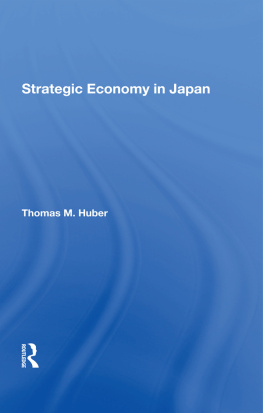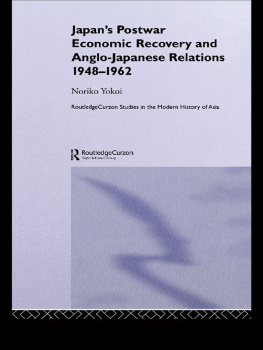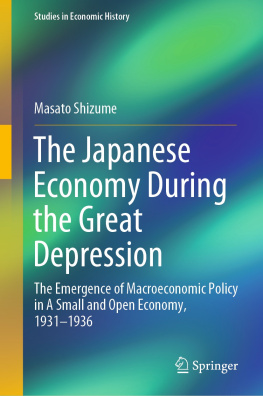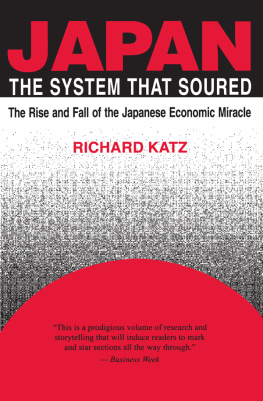Strategic Economy in Japan
First published 1994 by Westview Press
Published 2019 by Routledge
52 Vanderbilt Avenue, New York, NY 10017
2 Park Square, Milton Park, Abingdon, Oxon OX14 4RN
Routledge is an imprint of the Taylor & Francis Group, an informa business
Copyright 1994 Taylor & Francis
All rights reserved. No part of this book may be reprinted or reproduced or utilised in any form or by any electronic, mechanical, or other means, now known or hereafter invented, including photocopying and recording, or in any information storage or retrieval system, without permission in writing from the publishers.
Notice:
Product or corporate names may be trademarks or registered trademarks, and are used only for identification and explanation without intent to infringe.
Library of Congress Cataloging-in-Publication Data
Huber, Thomas M.
Strategic economy in japan I Thomas M. Huber.
p. cm.
Includes bibliographical references (p. ) and index.
1.JapanEconomic policy1989-2.Industry and stateJapan.
I.Title.
HC462.95.H84 1994
338.952dc20
93-43012
CIP
ISBN 13: 978-0-367-28885-3 (hbk)
I WISH TO THANK those who provided inspiration and confidence when I first began my study of strategic institutions, especially Denny, Roger, Jack, and George. I am also grateful to my colleagues for their generous encouragement and frequent advice when I was exploring the nature of strategic institutions in the early days Chris, George, Sam, and all the others. My students, too, by years of patient toil, have helped me to see more clearly, and I am grateful especially to Marks people for their elan and supportive spirit. Many useful suggestions for this text were offered by friends who were kind enough to read the manuscript, especially Chalmers and Bob.
Needless to say, the opinions and perspectives presented in this volume are those of myself alone, not of individuals mentioned here or of any institutions with which I have been affiliated. The views expressed in this book do not reflect the official policy or position of the Department of the Army, the Department of Defense, or the U.S. government.
Thomas M. Huber
J APANS ECONOMIC PERFORMANCE in the postwar era has commonly been described as miraculous. Japans extraordinary sustained growth has not been matched by any other major nation in modern history. Between 1952 and 1973, the Japanese economy grew at an average rate of nearly 10 percent per year. As a consequence, Japans gross domestic product (GDP) was more than six times as large in 1973 as it had been in 1952. By the end of this period Japan had the worlds second largest economy after the United States. In 1978 it would also pass the United States to become first in per capita production. By 1973 Japan was first in steel, ships, electronics, and optics. Later it would become first in autos, semiconductors, computers, and robotics as well. Moreover, by the mid-1960s, after 10 years of rapid growth, illiteracy, poverty, and unemployment had virtually disappeared from the society.
Fortunately in recent decades new scholarship has emerged from many quarters that has begun to make it possible to achieve a more fundamental understanding of some aspects of the Japanese miracle. A consensus has begun to take shape among students of government and of commercial institutionsnamely political scientists and scholars associated with business schoolsthat although Japan enjoys a vigorous private commerce, at the same time the Japanese government is somehow a participant in Japans techno-industrial system. The system seems to have the benefit of some kind of business-government partnership. My purpose here is to further this collective pursuit of understanding in some small way by bringing some of this new scholarship together, and also by exploring Japans distinctive economic arrangements in light of public institutional practices in the West, rather than exclusively in light of private commercial practices. This approach in itself is not new, of course, insofar as earlier observers have from time to time pointed out the similarity of certain Japanese economic practices to those of public institutions in the West.
For want of a better term, I will refer to the distinctive Japanese system, in which certain elements of the economy may have been brought under public sponsorship, as strategic economy. Conceptual insights into Japanese techno-industrial practices can be achieved by analogy to academic, ecclesiastic, diplomatic, and other public institutions in the West. Still, the most useful environments of reference may be those of public institutions that are normally guided by a national strategy, especially military institutions.
The first chapter of this study seeks to concisely describe how economic policy is made and by whom. It recounts the means by which Japans elite bureaucracy coordinates Japanese industry and the limits of this coordination, its objectives, and some unexpected advantages. sounds out the objectives of the international strategy and explores Japans strategic economic activity abroad. The final chapter is an attempt to achieve further insights into Japans strategic economy by examining it with reference to several Western scholarly and historical perspectives.
Notes
. Organization for Economic Cooperation and Development, The Industrial Policy of Japan (Paris: OECD, 1972) [hereafter OECD], p. 163. For industrial growth rates see Chalmers Johnson, MITI and the Japanese Miracle (Stanford, CA: Stanford University Press, 1982), pp. 45. For per capita GNP, see, for example, Ezra F. Vogel, Japan as Number One (New York: Harper and Row, 1979), p. 21.
. For this notion, cf. Ronald Dore, British Factory-Japanese Factory (Berkeley: University of California Press, 1973), pp. 27576; Clyde V. Prestowitz, Trading Places (New York: Basic Books, 1988), p. 156.
Part One
Domestic Strategy
1
MITI: Prosperos World
T HE TECHNO-INDUSTRIAL sectors of the Japanese economy appear to operate on principles of national well-being and security, somewhat in the manner of a modern strategic military or foreign policy system. Let us consider in brief how strategic-economic policy decisions are made, the methods by which such policies are implemented, and the objectives usually sought and achieved by these systems.
Making Policy: The Ministry of International Trade and Industry
Economic policy in Japan appears to be formulated initially by the elite bureaucracy, not by the elected National Diet. Policies relating to strategic industries are both fashioned and implemented by the Ministry of International Trade and Industry (MITI). MITI is possibly the most powerful institution politically, economically, and socially in Japanese society. Its several hundred senior operatives chart the future of Japan, Incorporated.
MITI officials do not shape policies in a void. They consult a senior advisory board called the Industrial Structure Council (ISC). The ISC consists of some 130 membersserving two-year termsdrawn from industry, finance, academia, and government. The councils chairman is the current chief of the powerful industrial umbrella association the Keidanren. The ISC is subdivided into industry-specific councils that issue a steady stream of white papers for their industries, appropriately called visions. In fact, however, ISC staff support is provided entirely by MITI, and the ISC is evidently cued by MITI as to the directions in which industry should move. It is likely that part of the ISCs function is to serve as a microcosm of the interested public constituencies so that MITI can gauge the response,







